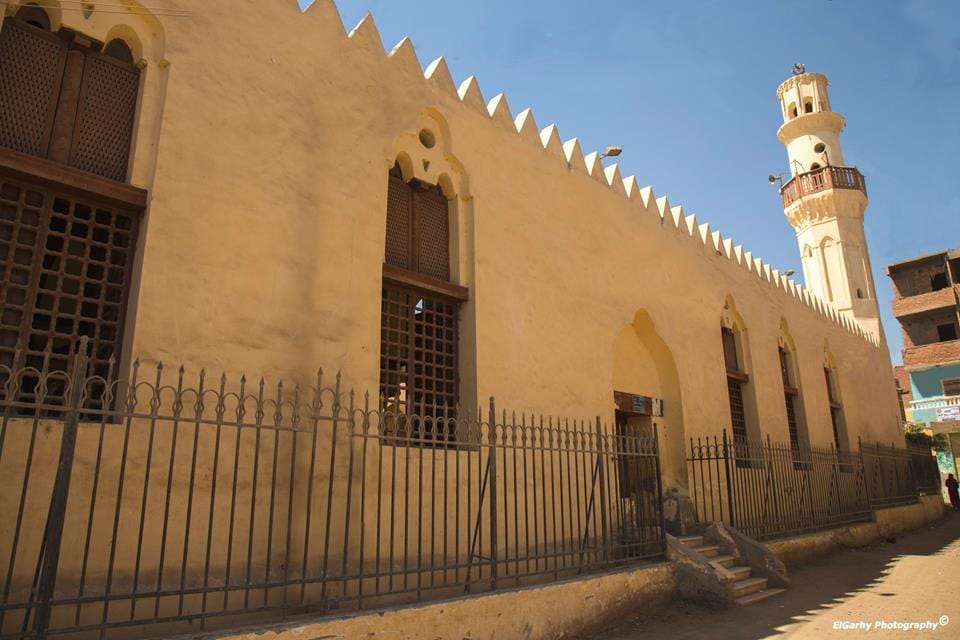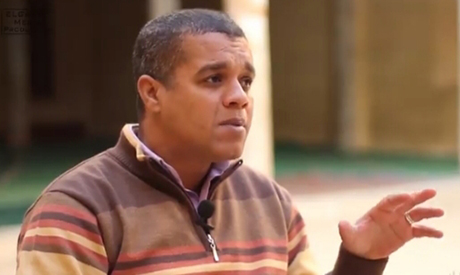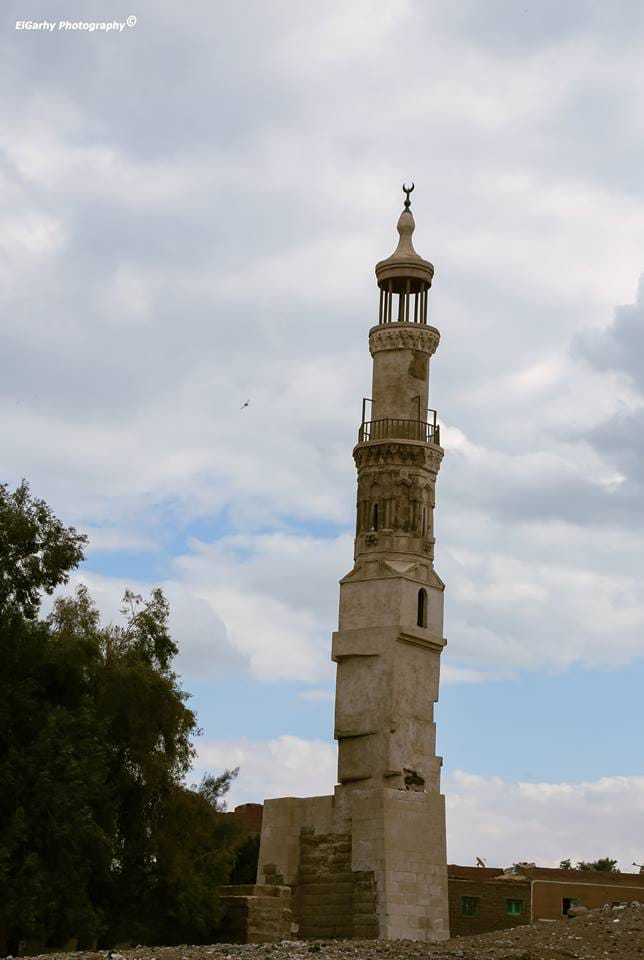The holy month of Ramadan and the months preceding it have always been a time when droves of Muslim worshippers, particularly Sufis, flock to seek the spiritual fulfilment and blessings of well-known members of the prophet’s family (ahl al-beit) and saints.
There is no doubting that mosques housing shrines for the ahl al-beit or saints have a different aura from others. Mosques like Al-Hussein, Al-Sayeda Nafisa, and Ali Zein Al-Abedine in Cairo, the Sidi Al-Morsi Abul-Abbas Mosque in Alexandria, and the Al-Sayed Al-Badawi Mosque in Tanta in the Delta are important cases in point. It is in these mosques that many Sufi worshippers seek to enter “the zone of love” that, in the words of Elif Shafak, author of the best-selling novel The Forty Rules of Love, is bound to “transform lives”.
However, perhaps fewer people know that many lives have also been transformed at the sanctuaries of Al-Bahnassa in Upper Egypt, once visited by 10,000 of the prophet’s companions and where 5,000 of them lie at rest under its soil. The Al-Bahnassa Cemetery, which also houses the tombs of at least 70 famous warriors who participated in the great Battle of Badr — a crucial battle in the history of Islam in which the prophet and his companions won against Quraish atheists in the early years of Islam — is thus called the “Second Baqi,” or the “Baqi Masr” (the Baqi of Egypt) after the original Baqi cemeteries located in Medina in Saudi Arabia, where all the prophet’s wives and most of his family and companions are buried.
“Al-Bahnassa was named Baqi Masr after a famous visit of the late grand imam of Al-Azhar, Sheikh Abdel-Halim Mahmoud, in the late 1970s,” said Salama Zahran, head of the Al-Bahnassa Islamic Monuments at the Ministry of Tourism and Antiquities. Zahran has been living in Al-Bahnassa for 19 years and is very well acquainted with the area’s history.
“The late grand imam took off his shoes on entering the Al-Bahnassa Cemetery, and when asked for an explanation, he asked ‘how could I wear shoes on land once trodden by 10,000 pairs of eyes who had witnessed the prophet and where 5,000 of the prophet’s blessed companions are buried? This is the Muslims’ second Baqi.’”

The mausoleum of Muhammed Al-Ghifarry (the son of Hadith narrator Abu Zarr Al-Ghifarry)
A virtual tour of the cemetery, at present partially closed to visitors as part of measures to halt the spread of the Covid-19 coronavirus and since the start of the restoration of 14 domes, immediately takes one on a spiritual journey into the early history of Islam. A glance at the tombs and ancient domes located in the historic cemetery is breathtaking; the view immediately invites curiosity to know more about the famous Islamic warriors and revered sahaba (companions) buried in the area.
The stories associated with this place make it an important destination for the many pilgrims who seek its blessings and a dream for those who have never been to the place themselves. The partial closure of the mausoleums is also heartbreaking for regular visitors, many of whom stand at the closed gates, praying for their reopening.
Before the lockdown in the wake of the Covid-19 pandemic, hundreds of villagers would regularly perform the Friday prayers in the area’s ancient mosques and visit the shrines in their quest for blessings. Sufi rituals were regularly performed there in the form of zikr meetings dedicated to the remembrance of God. Many families were keen on taking their children on visits not only in quest for blessings, but also, as one woman said, to educate her children and let them bond with the prophet’s companions.
“The whole place feels like paradise,” said a regular visitor to Al-Bahnassa and a resident of the Minya governorate who asked to have his name withheld. “It’s so inspiring to walk on the very land once trodden by the prophet’s close companions. We take off our shoes in awe. The sanctuaries leave one awestruck and spiritually connected with the prophet (PBUH). You feel speechless when you read the names inscribed over the tombs.”
For many Muslim Egyptians, it is a source of honour and a blessing for Egypt that such revered sahaba are buried on its soil. But it is also a great loss that only a few people are aware of this great honour, since the tombs are not well-known and are not well-marked on visitor maps.
However, this will soon change. According to Zahran, a comprehensive plan is well underway to restore the mausoleums and to upgrade the area.
“Al-Bahnassa will soon be marketed as one of Egypt’s visitor destinations,” Zahran said. “The area is very rich in history and exudes a comforting spirituality and blessings that are immediately felt by visitors. Although Al-Bahnassa remains largely unknown to many Egyptians, we have regular visits from Malaysian, Indonesian, and Thai students studying at Al-Azhar. Its mausoleums deserve to be well preserved and advertised so that more people get to know the place and have the chance to enjoy its historic aura and benefit from its blessings.”

The ancient mosque of Al-Hassan Al-Saleh
HISTORY OF AL-BAHNASSA: What is the story of the ancient village, and why is it so important to many Muslims?
The village of Al-Bahnassa, characterised by many layers of history and home to many archaeological sites dating to different eras in the history of Egypt, is located in the centre of Bani Mazar in the Minya governorate of Upper Egypt.
The cemetery, extending over 90 acres, includes 15 domes registered with the Ministry of Tourism and Antiquities and the tombs of villagers as well as the tombs of people from Cairo and Alexandria who wished to be buried beside the prophet’s revered companions.
“The Al-Bahnassa village is mentioned in many books as having been a stronghold of the Romans [Byzantines] at the time of the Islamic conquest of Egypt,” Salama told Al-Ahram Weekly. “It was a large city encircled with fortified walls that had four gates in them with three towers at each gate.”
The area also features churches and palaces dating back to different historical eras. Ibn Battuta, a Muslim Berber-Moroccan scholar, jurist, and explorer who travelled the world in the 14th century CE, described Al-Bahnassa as “a big city with wide gardens famous for its textiles”, according to Salama. Ibn Battuta said he had met many famous scholars at Al-Bahnassa, including revered scholars Sharafeddin and Sheikh Abu Bakr Al-Agmi and historian Al-Waqidi.
According to Ibn Battuta, the ancient city was home to “10,000 pairs of eyes that had witnessed the Prophet Mohamed (PBUH), as well as 70 of his companions who had participated in the Great Battle of Badr,” he added. The Muslim historian Al-Waqidi (c. 130-207 AH, 747-823 CE) also confirmed that 5,000 of the prophet’s companions had been martyred and buried in Al-Bahnassa.
When the Arab conqueror Amr Ibn Al-Aas conquered Egypt, then under the rule of the Byzantine Empire, he won battles against the Byzantine forces, taking the fortress of Babylon and the governorates of Cairo and Giza. However, he also wanted to head south and asked permission to do so from the caliph Omar Bin Al-Khattab.
Upper Egypt possessed two main Byzantine strongholds, Ahnassa and Al-Bahnassa, and conquering them would mean Muslim rule extending over Egypt’s south. Ibn Al-Khattab advised Ibn Al-Aas to send one of his knights to conquer Al-Bahnassa.
Ibn Al-Aas sent Qais Ibn Al-Haris Al-Muradi, one of the prophet’s companions, to conquer Al-Bahnassa. Al-Muradi headed south, stayed in a city near Al-Bahnassa that was later named Al-Qais after its conqueror, and imposed a siege around Al-Bahnassa, Salama said. A Byzantine army attacked the Muslim forces, and a fierce battle took place.
Ibn Al-Aas asked for the support of an army led by Khaled Ibn Al-Walid. But the caliph sent him an army of 300 knights led by Abi Abdullah Ibn Al-Zubeir instead. When the battle grew fierce, the caliph sent another army under the leadership of Al-Mikdad Ibn Al-Aswad, known as the “undefeatable warrior” who had never led a defeated army, followed by yet another 200 knights led by Dirar Ibn Al-Azwar. Another 200 were later sent under the leadership of Abdullah Ibn Amr, the caliph’s son, followed by Oqba Ibn Amer Al-Juhani with yet another 200 warriors.

Zahran
The Muslim armies won the battles, and Al-Bahnassa fell under Muslim rule that now extended to all parts of Upper and Lower Egypt. However, thousands of early Muslim scholars and companions were martyred in the battles of Al-Bahnassa, which explains why it is called the “city of martyrs” today.
The great names inscribed on the domes of the tombs in Al-Bahnassa are awe-inspiring to its visitors and make it no less a sanctuary than its sister in Medina in Saudi Arabia. The prophet’s grandson, as well as the sons of the Rashidi caliphs Abu Bakr Al-Seddiq, Omar Ibn Al-Khattab, and Othman Bin Affan, are buried there, and this is not to mention the large number of companions of high rank in the history of Islam who are also buried at Al-Bahnassa.
Among the most revered names inscribed on the domes are those of Abbas Bin Othman Bin Affan, Mohamed Bin Okba Bin Amer Al-Jahni, Mohamed Bin Abi Bakr, and Mohamed Bin Abi Zar Al-Ghifari. Other domes bear the names of other revered sahaba like Mohamed Al-Kharsi, Al-Hassan Al-Saeh and Al-Sayeda Ruqaya.
The two mostly visited domes, a must-see for Sufi worshippers, are those of the Sanctuaries of the Seven Girls, a place where men and women seek blessings for the cure of illnesses and where women touch the soil in the hope of conceiving. There is also the dome of Sidi Abu Mohamed Youssef Bin Abdullah Al-Takrouri, named after Moroccan emir Al-Takrouri who was known for his piety.

The minaret of Abdel-Hai Zein El-Abedeen (the grandson of Ali Ibn Abi Taleb and Fatemah, the Prophet’s daughter)
Many villagers seek the blessings of Al-Takrouri, holding festivities such as mawalid and zikr sessions. The festivities were regularly held in pre-coronavirus times at the Al-Takrouri Mausoleum and Mosque, where participants report having received karamat, or special blessings. The Al-Takrouri sanctuary is particularly linked to stories suggesting that images of the battle between the Byzantines and the Muslims that took place in the area appear on the walls of the saint’s tomb during zikr processions by the devoted.
Visitors particularly feel a shiver of awe when they stand before the dome of the Badrites where the companions of the Prophet who participated in the Battle of Badr are buried.
The shrine of Hassan Al-Saleh bin Ali Zain Al-Abidine is another important site for anyone visiting the tombs of Al-Bahnassa. The sanctuary belongs to the prophet’s great-grandson, the grandson of Al-Hussein, the son of Ali bin Abi Talib and Fatima, the prophet’s daughter, and is located in one of Egypt’s oldest mosques that dates back to the Islamic conquest.
It is said that Egypt’s Copts, persecuted under Byzantine rule, supported the Muslim army during the Islamic conquest, and some historic accounts suggest that the Seven Girls Sanctuary includes the tombs of seven Christian nuns who played a role in the historic Al-Bahnassa battles in support of the Muslim army and were slaughtered by the Byzantines in revenge.
Salama, however, thinks that the story is unfounded and that the seven girls who helped the Muslim army were not nuns.
NEGLIGENCE: It seems that there is also more to Al-Bahnassa than the Muslim sanctuaries.
It has witnessed many layers of history and also includes ancient Egyptian, Coptic, and Graeco-Roman antiquities that make it an important site for both local and foreign tourists. It includes a Mary’s Tree, a tree under which the Virgin Mary rested during her flight to Egypt and the Holy Family’s journey through the country.
However, little attention has been granted to the area, which has suffered from negligence for decades and remains largely unknown to many Egyptians and foreign tourists alike. According to Zahran, about 16 domes and mosques were registered as antiquities at Al-Bahnassa in 2001, but before that date the restoration work had been limited to a few individual efforts that were far from professional in standard.
“People had volunteered to paint or furnish the mausoleums in quest of blessings, but the ancient domes and mausoleums were literally crumbling due to years of negligence,” he said. There has not been a single government effort to save the mausoleums or list the monuments in publications describing the site since their registration with the Ministry of Tourism and Antiquities.
“The Mosque of Al-Hassan Ibn Al-Saleh, burned during the Fatimid era and rebuilt by the Ottomans, was restored in 1995, while the maazana of Abu Samra was restored in 2007,” Zahran said. “But none of the mausoleums have been restored, and there are serious cracks on their walls.”
It was only in 2020 that Minister of Tourism and Antiquities Khaled El-Enany visited Al-Bahnassa and brought it into government focus.
“The minister earmarked a budget of LE40 million for a two-stage plan to restore the area,” Zahran said. The first stage of the project, entitled “defeating dangers”, is meant to protect 16 historic domes from crumbling and to restore them to their original state. The ministry of antiquities is funding the project, which is implemented by the military-affiliated National Services Company.
“The first stage is critical because we are trying to respect the original structure using materials that match the original ones and that will not affect the ancient walls of the mausoleums,” Zahran explained. “It’s more like maintenance work that attempts to restore the domes to their original shape and protect them against the damage of time and the weather, while also undoing the harm of previous restoration attempts by volunteers and villagers.”
The second stage will be more comprehensive, he said. “It will include upgrading the whole area, paving the roads leading to the mausoleums, and putting up signs that explain the historic significance of the place to visitors. The mausoleums will be properly lighted and will be encircled with fencing to protect them against theft. The area will also be furnished with seats, signposts, and bathrooms for visitors who come to enjoy the tour.”
“The ministry’s vision is that Al-Bahnassa is of no less importance than well-known historic areas of Cairo like the Fatimid Al-Muizz Street that has been restored. It deserves to be at the centre of government attention,” Zahran concluded.
*A version of this article appears in print in the 29 April, 2021 edition of Al-Ahram Weekly
Short link: